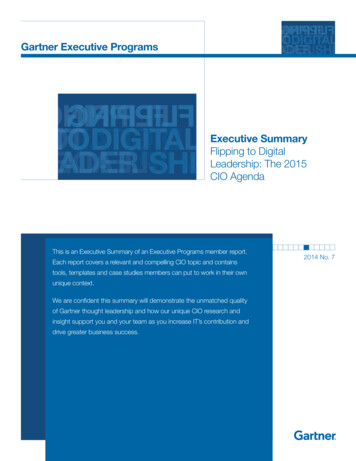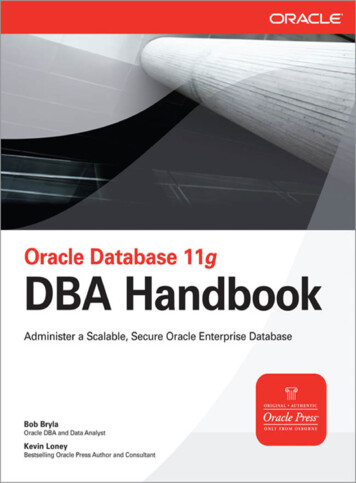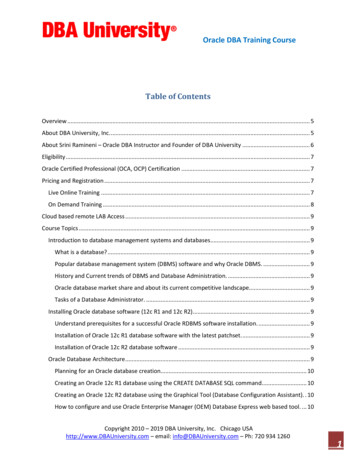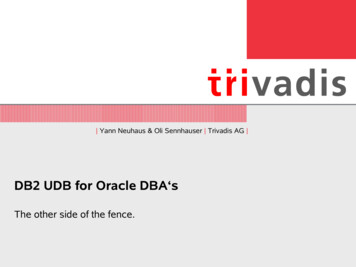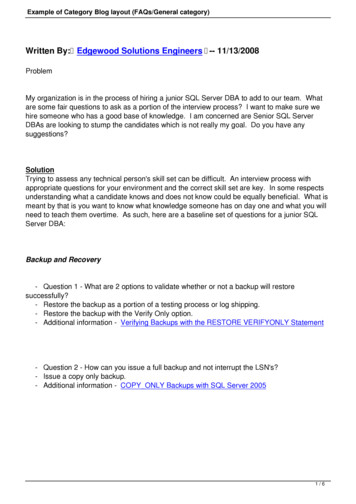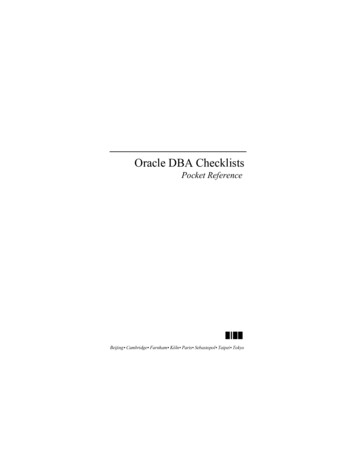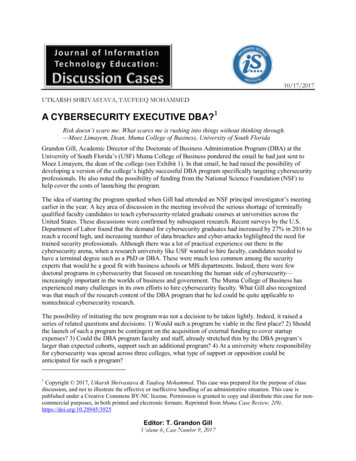
Transcription
10/17/2017UTKARSH SHRIVASTAVA, TAUFEEQ MOHAMMEDA CYBERSECURITY EXECUTIVE DBA?1Risk doesn’t scare me. What scares me is rushing into things without thinking through.—Moez Limayem, Dean, Muma College of Business, University of South FloridaGrandon Gill, Academic Director of the Doctorate of Business Administration Program (DBA) at theUniversity of South Florida’s (USF) Muma College of Business pondered the email he had just sent toMoez Limayem, the dean of the college (see Exhibit 1). In that email, he had raised the possibility ofdeveloping a version of the college’s highly successful DBA program specifically targeting cybersecurityprofessionals. He also noted the possibility of funding from the National Science Foundation (NSF) tohelp cover the costs of launching the program.The idea of starting the program sparked when Gill had attended an NSF principal investigator’s meetingearlier in the year. A key area of discussion in the meeting involved the serious shortage of terminallyqualified faculty candidates to teach cybersecurity-related graduate courses at universities across theUnited States. These discussions were confirmed by subsequent research. Recent surveys by the U.S.Department of Labor found that the demand for cybersecurity graduates had increased by 27% in 2016 toreach a record high, and increasing number of data breaches and cyber-attacks highlighted the need fortrained security professionals. Although there was a lot of practical experience out there in thecybersecurity arena, when a research university like USF wanted to hire faculty, candidates needed tohave a terminal degree such as a PhD or DBA. These were much less common among the securityexperts that would be a good fit with business schools or MIS departments. Indeed, there were fewdoctoral programs in cybersecurity that focused on researching the human side of cybersecurity—increasingly important in the worlds of business and government. The Muma College of Business hasexperienced many challenges in its own efforts to hire cybersecurity faculty. What Gill also recognizedwas that much of the research content of the DBA program that he led could be quite applicable tonontechnical cybersecurity research.The possibility of initiating the new program was not a decision to be taken lightly. Indeed, it raised aseries of related questions and decisions: 1) Would such a program be viable in the first place? 2) Shouldthe launch of such a program be contingent on the acquisition of external funding to cover startupexpenses? 3) Could the DBA program faculty and staff, already stretched thin by the DBA program’slarger than expected cohorts, support such an additional program? 4) At a university where responsibilityfor cybersecurity was spread across three colleges, what type of support or opposition could beanticipated for such a program?1Copyright 2017, Utkarsh Shrivastava & Taufeeq Mohammed. This case was prepared for the purpose of classdiscussion, and not to illustrate the effective or ineffective handling of an administrative situation. This case ispublished under a Creative Commons BY-NC license. Permission is granted to copy and distribute this case for noncommercial purposes, in both printed and electronic formats. Reprinted from Muma Case Review, 2(9).https://doi.org/10.28945/3925Editor: T. Grandon GillVolume 6, Case Number 9, 2017
SHRIVASTAVA, MOHAMMEDDeveloping Cybersecurity ProfessionalsA complex system of wired and wireless networks connected individuals and organizations across theworld. As the world order became increasingly dependent on the exchange of information through thesenetworks, ensuring the security of these networks—keeping access to these networks available, whilemaintaining the privacy of data contained within them and protecting from unauthorized destruction ormodification—was becoming a top priority. Unfortunately, the goal of accessibility tended to conflictwith that of protecting data. Thus, cyber-attacks had become so contagious that the saying “One bad fishcan spoil the whole pond.” fitted well in the context of computer networks. A record 79% of the U.S.businesses reported a cybersecurity incident in the year 2016, and the reporting organization believed thatit was the best-case scenario as they expected that many of these incidents were either not detected or notreported (Raytheon, 2015).Demand for ProfessionalsWith an increase in the cybersecurity related incidents, the demand for professionals with expertise inmonitoring and securing IT infrastructure was also going up. Businesses had started taking theinformation security concerns more seriously, and it was expected that the cybersecurity market wouldgrow from 75 billion in 2015 to 170 billion by 2020 (Morgan, 2015). A career in cybersecuritydemanded creativity as well as analytical and technical prowess, but it offered diverse options for theaspirants. The cybersecurity career track included designations such as Cyber Behavior Scientist (tostudy human behavior), Vulnerability Researcher (to identify pitfalls and weaknesses in software) andInformation Assurance Engineer (to protect hardware from cyber-attacks). The Department of HomelandSecurity listed at least 31 common areas within the cybersecurity profession that prospective jobcandidates could choose from (NICCS, 2017).According to the leading security firm Symantec, there would be a shortfall of 1.5 million cybersecurityprofessionals by 2019 against the total global demand of 6 million (see Exhibit 2). To address theexpected shortfalls, universities needed to add cybersecurity programs. A serious constraint that limitedthe development of such programs was the shortage of qualified faculty, particularly research faculty. Ina 2013 report, the National Academies of Science characterized cybersecurity as an emerging discipline.As with most of the emerging fields, there were few graduate programs in the area, and the curriculumwas not coherent amongst them. This resulted in different departments (such as engineering, business orlaw) in the same university offering their own versions of cybersecurity education. Gradually, academicswere coming to the realization that cybersecurity was an intrinsically interdisciplinary area. Focusingonly on the technical aspects related to cybercrime would hinder the development of useful solutions.The ideal researcher would be able to draw upon multiple perspectives, both technical and behavioral.Existing Educational StructuresThe first step in the direction of formalizing the education given to cybersecurity students in the collegeswas taken by the National Security Agency (NSA). The National Center of Academic Excellence inCyber Defense (NCAECD) program was started in 1998 to produce graduates that met the specific needs(mostly related to coding ability) of the agency. This move by the federal agency encouraged manycolleges to focus on the technical aspects of cybersecurity. By 2016, about 200 colleges had earned thedesignation given by NCAECD which ensured the students and the employers that the cybersecurityeducation followed the standards set by NSA (NSA, 2016). In addition, the Department of Education andNSF were also partnering to develop cybersecurity programs based on science, technology, engineeringand math (STEM) disciplines to address the shortage of the skilled workforce. The acute shortage ofworkforce meant that even the graduates with non-STEM focused degrees could get entry level jobs aftergetting the requisite training from the hiring firms.2CyberDBA
JITE: DISCUSSION CASESVolume 6, Case Number 9, 2017Early cybersecurity programs focused mainly on the technical coding skills as they were required by theNSA and were also a key component of the curriculum developed under NCAECD. The cybercriminals,however, kept on defying odds and developed creative ways of getting access to the vulnerable systems.Their success was attributed to variability, and delay in adoption of updated systems and protocols at theglobal level. The computer networks or internet functioned as an integrated system, and an outdated nodeor protocol in the network could become an opening for a contagious cyber-attack. One of the reasons forhackers having the upper hand was their ability to identify weak links and avenues for cyber-attacks fromcomputers and humans operating them. They had the knack of getting their job done even in the presenceof a secure hardware/software apparatus in place. It was becoming clearer that human behavior played akey role in cybercrimes and was something which could not be modeled using mathematical algorithmsor by learning coding skills.Emerging NeedsThe researchers in the cybersecurity area suggested the need for training a new breed of professionalswho could understand the human and legal aspects of the cybercrimes (Shoemaker & Kohnke, 2016).The need of the hour was to determine the avenues for a cyberattack before the hackers did and takeappropriate actions to prevent it. On the other hand, if such an attack took place, then a cybersecurityexpert should understand the criminal law and computer forensics to be able to track and find evidence,and prosecute the attacker. Paralleling what researchers were recognizing, educational institutions beganto construct cybersecurity programs as interdisciplinary concentrations that required students to learn avariety of topics before graduation. To achieve this, the faculties had started adding cybersecurityelectives or concentrations in engineering, management, and psychology degrees as well. The U.S. NavalAcademy started teaching technical skills in the early years of its undergraduate program, then applyingthese learned skills to policy, law, and other fields in the later years of the program. NortheasternUniversity branded their cybersecurity graduates as “cyberliaisons” for their expertise in computers andpolicy related issues while Le Moyne College in Syracuse marketed their cybersecurity program as“cybersecurity for presidents” aimed at producing corporate leaders.Cybersecurity Doctoral ProgramsCybersecurity programs were seeing a massing jump in the number of enrollments. For instance, theenrollment to Dakota State University (DSU) cybersecurity program rose by more than 200% within aspan of five years while it increased by more than 300% at Harvard University within two years (Raposa,2017). Apart from job security, top tier institutions such as Harvard and Indiana University customizedtheir cybersecurity curriculums to meet the requirements of marketing executives, lawyers, managers,and so forth. Even community colleges were witnessing an increase in enrollment in their cybersecuritycertificate programs--benefiting from lower costs, flexible academic requirements, and attractiveemployment opportunities. Program development support was offered through security technologycenters and through projects sponsored by the NSF. The result: a surge in the number of cybersecurityprograms with around 200 new Centers for Excellence in Cybersecurity within a span of 9 years.The sudden rise in the number of enrollments and new cybersecurity graduate programs was in turnleading to a shortage of terminally qualified faculty candidates for the teaching positions. Institutionssuch as University of Connecticut and University of South Florida were advertising dozens of facultypositions in the cybersecurity area. There was no shortage of candidates with applied field experience incombating cybercrimes. Those holding terminal degrees in the area were scarce, however. With morethan 200 schools offering cybersecurity credentials ranging from certificates, associate’s, bachelor’s andmaster’s degrees--the doctoral degree appeared to be the next logical step (Collins, Soo Hoo, Krantz, &Cosgrove, 2012).CyberDBA3
SHRIVASTAVA, MOHAMMEDMost of the doctoral degrees with a cybersecurity concentration were offered by the computerengineering departments across the United States. The students enrolled into these programs had theoption to typically choose amongst the two focus areas of “information security” and “informationassurance.” A computer science PhD degree with “information security” focus generally emphasizedconcepts related to computational practice such as algorithms, network architecture, and artificialintelligence. A PhD in computer science with an “information assurance” focus area emphasized theimpact of cyber laws, policy, and human behavior on the security preparedness. Typically, a computerscience undergraduate degree was an essential requirement for getting admission to these programs, andfull-time residency was also a frequent requirement. An example of the structure of a typical program,offered by Arizona State University, is presented in Exhibit 3.Some institutions such as Purdue University offered interdisciplinary PhD programs in informationsecurity. These programs were essentially started for the students who had a different set of skills andbackground, or had done research in topics that were difficult to support in the existing disciplines.Cybersecurity being an emerging field and known for its multidisciplinary focus was expected to attractstudents in such interdisciplinary programs. At Purdue, the program was sponsored by the departments ofcommunication and philosophy, college of technology and program linguistics. These departments hadan option to specify their own requirements for the program students. Interestingly, though computationalbackground was preferred, the admission committee was flexible regarding the undergraduate major.External funding sources, such as NSF, provided financial support to studies that bridged gaps across thedisciplines. Iowa University responded to the needs of the students and the priorities of the fundingagencies by bringing together the faculties of different departments, such as engineering, mathematics,and political science within its Information Assurance Center (IAC). IAC offered graduate level courses,master’s degrees, and certificates in various areas within information assurance, but did not grant PhDdegrees. Instead, students pursuing a PhD in other departments had the option of taking graduate levelcourses offered by IAC for a doctoral specialization in information assurance. The IAC was alsoaccredited by NSA as the Center of Excellence in Cyber Defense Research.Apart from traditional disciplines such as engineering, mathematics, and political science--otherinterdisciplinary areas such as information science also had a lot in common with cybersecurity.Information science as a research domain focused on areas related to retrieval, storage, dissemination,and protection of information. Since cybersecurity research was also concerned with the informationprotection, a few institutions offering information science terminal degrees also had a cybersecuritytrack. For instance, an information science PhD with a focus on information security offered by theSchool of Computing and Information at University of Pittsburg trained students to do research indeployment and design of secure information systems.Amongst business schools, the Eller School of Management at the University of Arizona offered a PhDdegree in Management Information Systems with a minor in Information Assurance. The minorrequirement was determined by the department offering it. Hence, students were expected to take coursesoffered by the interdisciplinary center of information assurance. A minimum of nine credit hours ofcourses were required to be completed for fulfilling the minor requirements. More broadly, individualstudents enrolled in MIS PhD programs often had considerable latitude in choosing their own researchfocus. As a result, they could choose to direct their dissertation towards cybersecurity-related topics. Indoing so, they could often qualify for cybersecurity faculty positions.4CyberDBA
JITE: DISCUSSION CASESVolume 6, Case Number 9, 2017Business DoctoratesIn the U.S., business doctorates could be acquired with two broad objectives in mind. The first, and mostcommon, was to establish a career as an academic researcher. The second was to learn research methodsso they could be applied to practice.PhD Degrees in BusinessThe focus of traditional doctorates in business was to produce faculty members qualified to conductresearch and teach in business schools. In the U.S., the earliest of these doctorates (the Doctor ofBusiness Administration degree introduced by Harvard Business School) had an applied andinterdisciplinary focus. The participants in these early programs normally entered only after havingsubstantial careers as practicing managers.By the 1960s, however, business doctoral education had started moving in a much more theoreticaldirection. Research disciplines built around the core business functions (e.g., management, accounting,finance, marketing and, later, information systems) began to appear. Business journals becameincreasingly specialized, and the creation of new theory became the researcher’s ideal. With this change,the PhD—closely resembling its social science counterparts in economics, psychology, sociology, anddecision science—became the typical (and preferred) degree for academic researchers. The programsmost successful at placing graduates, offered by top research universities, had extremely competitiveadmissions standards, and required students to attend full-time. Commitment to business research—in thecontext of launching a full-time academic career—rather than commitment to business practice, was theguiding criterion for selecting students.Executive DoctoratesStarting in the 1990s, a new type of business doctoral program began to emerge in the U.S. Theseprograms were part-time and designed for executives with a minimum of 7-12 years of work experience.These programs bore some resemblance to professional doctoral programs that had earlier developed inthe U.K. and Australia. The U.S. programs differed, however, in their heavy reliance on coursework andtheir use of cohort structures to move groups of students through the process at the same time. Most U.S.programs awarded the DBA degree, to distinguish them from traditional PhD programs. Others inventedtheir own degree, such as Case Western Reserve University’s (CWRU) Doctor of Management andGeorgia State University’s (GSU) Executive Doctorate in Business (EDB). Unlike the traditional PhD ata research university, these DBA programs allowed students considerable flexibility in dissertationresearch, residency requirements, external employment policy (with continuing to work through theprogram being encouraged) and plan of study. Most were interdisciplinary or multi-disciplinary in theirfocus. Nearly all emphasized the application of research to practice. Nor did they assume graduateswould go on to pursue academic careers. Instead, many were expected to apply the research skills theyacquired to their existing careers or professions. Some key differences between these programs and thetraditional PhD are listed in Exhibit 4.The first U.S. program using the executive doctorate model at a major research university was started byCWRU in Cleveland, Ohio. The program focused on designing sustainable systems and graduatingcandidates were expected to develop the ability to think critically about the problems confronting anorganization, a community, a nation, and the world. By 2017 however, about 28 business schools(including USF) offered DBA programs across the U.S., with a similar number of programs appearing inEurope. The Executive DBA Council (EDBAC) formed in 2010 to serve as a platform for sharingexperiences and providing guidance to other schools who wished to start or enhance a DBA program. In2013, AACSB International, the premier accrediting agency for business schools, published a reporttitled: “The Promise of Doctoral Education” that was perceived to be quite favorable in its view of thisCyberDBA5
SHRIVASTAVA, MOHAMMEDnew categor
—Moez Limayem, Dean, Muma College of Business, University of South Florida . Grandon Gill, Academic Director of the Doctorate of Business Administration Program (DBA) at the . University of South Florida’s (USF) Muma College of Business pondered the email he had just sent

